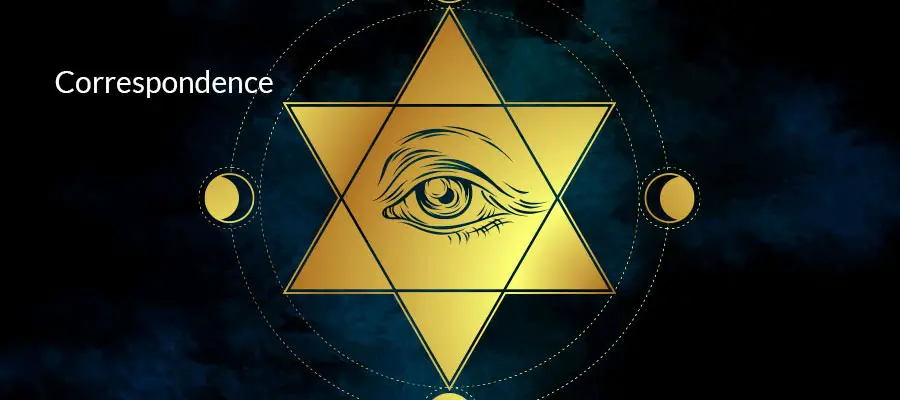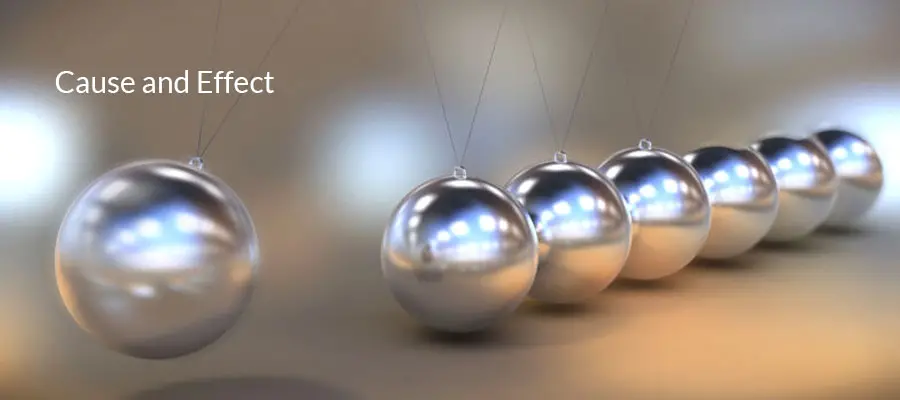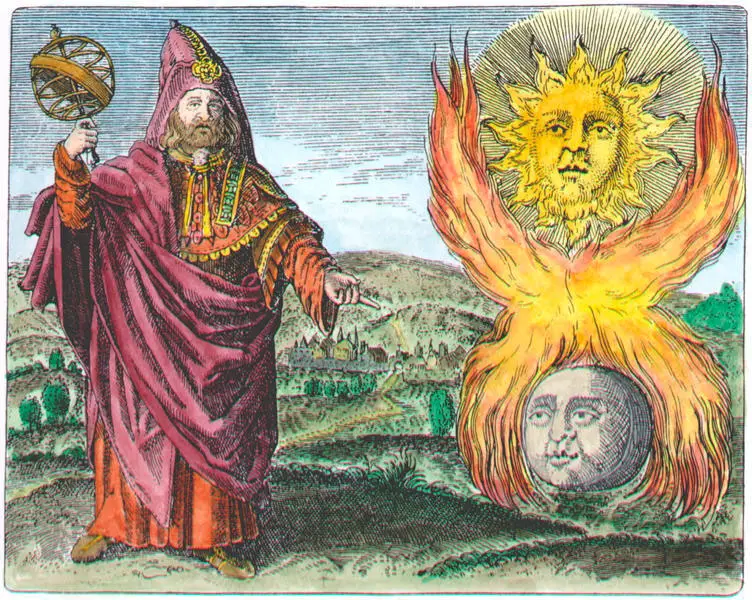The seven Hermetic principles are at the heart of the philosophical system known as Hermeticism, and can be traced back to at least ancient Egypt. In this article we are going to explore these seven principles and how they can be applied to our lives.
The seven Hermetic principles are Mentalism, Correspondence, Vibration, Polarity, Rhythm, Cause & Effect, and Gender. Together, these principles provide a full understanding of the dynamics that govern the universe. By working with these principles, one can obtain mastery over their own existence.
“The principles of truth are seven; He who knows these, understandingly, possesses the magic key before whose touch all the doors of the temple fly open.” – The Kyballion

1. The Principle of Mentalism
The All is mind; The Universe in Mental
This principle states that everything in the universe consists of thought, and is created by thought. In other words, “All is Mind”. Everything that exists, whether in the physical universe, or as abstract concepts or pure energy, which you could call “the All”, is made of spirit, which itself is the product of a universal living mind. This universal mind is in all things, even ourselves. And like the universal mind which creates all that is, we create our lives and our reality by our thoughts.
Application:
Realizing that all is mind means we must choose construct the inner-workings of our mind with proper reverence of its importance. Like a garden we must water the thoughts in our mind, and pluck out the weeds, We use the power of focused thought and visualization to change our reality and manifest what we desire. By mastering our thoughts, we gain mastery over our experience of life, as the keys to the mental nature of the universe become available to us.

2. The Principle of Correspondence
As above so below, as below, so above
The famous phrase, created by Hermes, beautifully sums up this principle. There are infinite planes of reality which are all a reflection of each other, and are all interconnected. What is true on one plane is also true on all planes of existence.
For example, the planets orbiting around the sun bears resemblance to an atom and its surrounding electrons. The swirling Fibonacci patterns seen in global weather trends mirror the growth patterns of small plants, just on a vastly different scale.
A true understanding of the axiom of correspondence opens up a far greater understanding of the laws which govern reality. The many planes of existence that are beyond our ability to perceive become understandable to us, as we know that they are a reflection of the planes that we do perceive. What happens on the inside also happens on the outside. What we think and feel manifests in the external circumstances of our lives. To read more about the meaning of As Above, So Below click here.
Application:
By understanding this principle, we begin to realize that making changes in one area of our lives in turn effects all areas of our lives. We are able to gain intuitive signals and insights about external situations from within your mind, because we understand we as individuals are a reflection of the macrocosmic universe in which we inhabit.

3. The Principle of Vibration
Nothing resists; everything moves; everything vibrates.
All things, wither they are physical or spiritual, hold a certain vibration. From spirit to the grossest level of matter, everything is vibrating at its frequency. Every molecule in the universe is vibrating, as well as our thoughts and emotions.
In recent years this ancient wisdom has been verified by modern science. New scientific tools created in the last couple years allow us to perceive the vibratory nature of our reality, on an atomic level. While modern science has verified this as being true, as a Hermetic principle it has been known for thousands of years.
The difference between matter and energy is simply a difference in the rate of vibration. The scale of vibration ranges from the highest vibrations which are so rapid that it is practically at rest, down to the most gross forms of matter, vibrating at such a low rate so as to also almost be at rest. Between these two poles exist all that is on varying vibrations.
When we are communicating with others, we perceive whether or not we trust somebody based on their vibe. Different genres of music are considered to have a different vibe. Similarly, our emotions have vibrations. When a happy person makes a sad person feel better, they are uplifting them because they are literally helping the person feel emotions that have higher vibrations.
Application:
The principle that everything vibrates is true for all aspects of life. By being aware of vibration, we can consciously alter our own vibration, through our thoughts, our choices of foods, as well as the colours, and sounds we have in our environment. Incense is a powerful method of effecting our vibration.

4. The Principle of Polarity
Everything is dual, everything has its opposite, opposites are identical in nature but different in degree.
This principle states that all that exists also has its opposite, and cannot exist without it. But that the opposite is in fact the same. Everything is dual, and everything has two poles. For example, in the polarity of hot and cold, one is merely the absence of the other, but in fact they are both a temperature. They are the two poles of what we call heat. This principle contains the axiom “all truths are but half-truths”, and “all truths are half-false”. Take the polarity of light and dark. As you move across from one side to the other, when does dark become light? The transition point is unclear because they are the same thing, and extreme light prevents us from seeing just as much as extreme dark does.
Application:
To understand the principle of polarity makes us less rigid and dogmatic in our thinking. Rather than jumping to conclusions we maintain a state of open-minded appreciation. The practitioner of Hermeticism understands that polar opposites can be transmuted into one and other, in a form of mental alchemy, an awareness that greatly amplifies ones abilities to manifest in their lives.

5. The Principle of Rhythm
Everything flows in and out, everything has its tides, all things rise and fall.
The principle of rhythm states that everything has a to and fro motion, or a swinging backward and forward motion, like a pendulum. This unending movement exists between opposing poles within a polarity. There is an advance and a retreat. A rising and a sinking. We breath in and out. The gravitational pull of the moon creates perpetual tides in the bodies of water on our planet. We see it in the rising and setting of the sun, and in our own daily routines of waking up before eventually going back to sleep. It exists in the rise and fall of civilizations. For every action there is an equal and opposite reaction.
Application:
The Hermeticist who gains mastery of this principle ceases to be the victim of rhythm, working with it instead of against it. He knows when to rest, and when to ride the rhythmic swing to the other side of the pendulum. By understanding rhythm, we can flow with the universe, knowing when to exert force, and when to rest or simply allow things to unfold on their own.

6. The Principle of Cause and Effect
Every cause has its effect, every effect has its cause.
This principle states that everything happens for a reason, and everything in the universe is governed by laws. There is no such thing as chance. The higher planes dominate the lower planes, which can cause the things that occur in our lives to seem a mystery to us at times, because we are limited by our human perception, and cannot see the full picture of all that is at play. While most people go through life as a victim of their own thoughts and feelings, and the circumstances that are created, The Hermeticist strives to become the cause, rather than the effect, of his own life. Most people are like pawns on the chessboard, obedient to external causes coming from people and forces more powerful than themselves. Part of the way of the Hermeticist is to rise to higher planes in their consciousness, and become cause on that higher plane, effecting the lower planes with their influence. They master their own internal experience first, and then the external environment around them. The true adept knows to not try to reject causation of the higher planes, but to work with and while also exerting their own influence.
Application:
By becoming the cause of our life, and also by becoming aware of the influences that are causing the effects we are experiencing, we become sovereign We become the designers of our own reality, creating our life out of choice, rather than accepting what happens to us without question.

5. The Principle of Gender
Gender is in everything, and manifests on all planes.
Everything has masculine or feminine qualities. Gender is manifested in everything. All planes of existence express this principle, there is no creation, physical, mental, or spiritual, which does not contain gender. But everything male also contains the female, and everything female contains the male. Humans are born as either male or female, and at all times are either expressing masculine or feminine traits. Masculine and feminine is embedded in our language, with many languages assigning a gender to all nouns. The gender polarity exists on the macro level as well, with the sun representing masculine energy and the moon feminine. The masculine is the creative force, while the feminine is soft and reflective. While opposites, they are inseparable, part of a larger picture, that when balanced part in unison to enhance one and other.
Application:
Awareness of how the principle of gender is at play in the universe opens one’s eyes to the beautiful interplay between the masculine and feminine. It allows us to achieve balance, both in ourselves as well as in our relationships with others.
The Seven Principles were Taught by Hermes Trismegistus
These seven principles come from the system of philosophy known as Hermeticism, which also contains many other branches of knowledge. It also encompasses alchemy, and other forms of high magik. The system of philosophy is attributed to Hermes Trismegistus, who is seen as a sort of king, philosopher and priest. The name Trismegistus means thrice greatest Hermes, and was the name given to Thoth during the Hellenistic age. It is a syncretic combination of the Egyptian god Thoth, and the Greek god Hermes.
Out of recognition that Thoth and Hermes are in fact the same immortal being, Hermes Trismegistus was credited with both the achievements of Thoth during ancient Egypt, and also Hermes during ancient Greece. Thoth was considered the inventor of writing, while Hermes, portrayed holding his caduceus staff, was the messenger of the Gods.
The Hermetic Philosophy is not a religious organization in the sense of Christianity, but rather a collection of ideas that were embraced by various groups over a long period of time. Its presence can be found in ancient Egypt, as well as Alexandrian Judaism, Sumerian religion, Zoroastrianism, Platonism, Stoicism, and Pythagorianism. A core concept in Hermeticism is “prisca theologia”, which claims to be the true core doctrine at the root of all religions.

The Books of Hermes Trismegistus
According to historians, Hermes Trismegistus wrote forty-two books, although legends abound that in fact, he actually wrote thousands of books. The forty-two were kept in the great Library of Alexandria, which was eventually destroyed. What remained moved to the Islamic world in 400-600 AD, before eventually re-emerging in Europe during the Renaissance.
During the Medieval Europe Hermeticism was banned by the church, and the philosophy was forced underground. It was kept alive by secret societies such as the Freemasons, Rosicrucians, and the Hermetic Order of the Golden Dawn.
Of the forty-two books, ten deal with sacrifices, ten with sacred rites, and two were hymns to the gods, as well as rules for how kings should govern. Four books were about astrology, and six about medicine. Today only a small handful remain, although their authenticity is sometimes called in to question by skeptics. These have been compiled into the Corpus Hermeticum.
The Kybalion: A Study of the Hermetic Philosophy of Ancient Egypt and Greece
Is a book originally published in 1908 and has been responsible for the popularization of the seven Hermetic principles in modern time. The author of the book is “Three Initiates”, though many believe that the book was written by a man name William Atkinson, an influential and prolific writer in the 18th and 19th centuries. The book does an excellent job of describing the Hermetic principles in great detail.
The Influence of Hermetic Philosophy
Hermeticism’s influence can be found world-wide, in modern science, as well as Christian and Muslim philosophy. The tradition of Hermeticism spanned millennium, and reached Europe, the Middle East, India, and China. The ancient Greek philosophers were heavily influenced by Hermeticism, who in turn influenced the Renaissance and eventually the Scientific Revolution.
Millenia after the origins of Hermeticism, legendary thought leaders continue to seek wisdom in the teaching of Hermes Trismegistus. Copernicus, the Renaissance astronomer who proposed the Sun is the center of the solar system, rather than planet Earth, and Isaac Newton, perhaps the most influential physicist of all time, are but two of many such students of the philosophy
Alchemy is a branch of the Hermeticism, which was the precursor to modern chemistry. The astrological concepts introduced in Hermeticism paved the way for modern astronomy, instilling an appreciation, and keen eye turned towards the sky. Many concepts in modern philosophy and psychology can also be traced back to Hermeticism.
Recommended Reading
If you’d like to continue researching Hermeticism or any of the other topics discussed on this website, you can see which books I recommend by clicking here.

